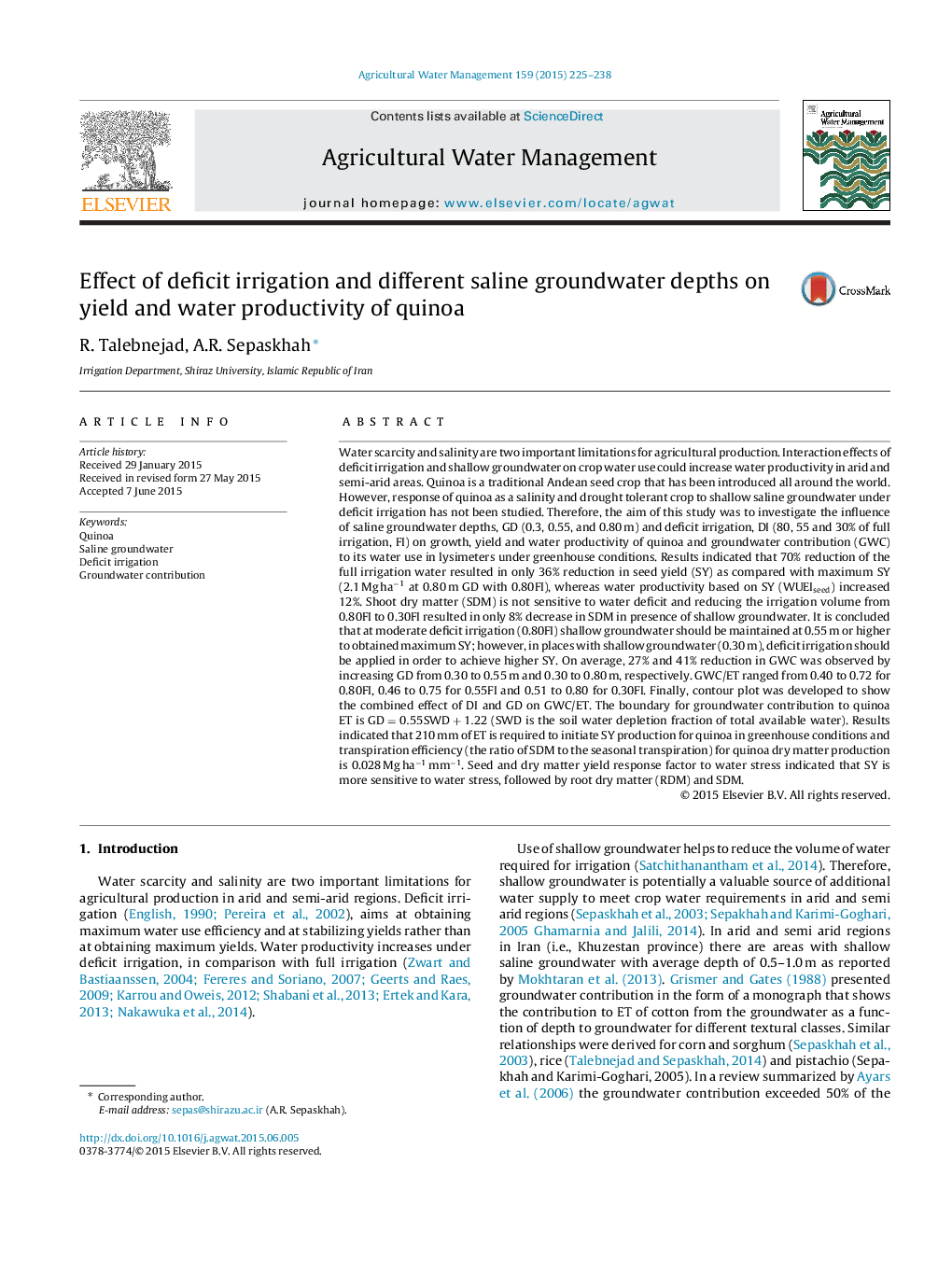| کد مقاله | کد نشریه | سال انتشار | مقاله انگلیسی | نسخه تمام متن |
|---|---|---|---|---|
| 6363727 | 1622920 | 2015 | 14 صفحه PDF | دانلود رایگان |
عنوان انگلیسی مقاله ISI
Effect of deficit irrigation and different saline groundwater depths on yield and water productivity of quinoa
ترجمه فارسی عنوان
اثر آبیاری کسری و عمق آبهای زیرزمینی مختلف شور در عملکرد و بهره وری آب چغندرقند
دانلود مقاله + سفارش ترجمه
دانلود مقاله ISI انگلیسی
رایگان برای ایرانیان
کلمات کلیدی
کوینو، آب های زیرزمینی سالین، آبیاری کمبود، مشارکت آبهای زیرزمینی،
موضوعات مرتبط
علوم زیستی و بیوفناوری
علوم کشاورزی و بیولوژیک
علوم زراعت و اصلاح نباتات
چکیده انگلیسی
Water scarcity and salinity are two important limitations for agricultural production. Interaction effects of deficit irrigation and shallow groundwater on crop water use could increase water productivity in arid and semi-arid areas. Quinoa is a traditional Andean seed crop that has been introduced all around the world. However, response of quinoa as a salinity and drought tolerant crop to shallow saline groundwater under deficit irrigation has not been studied. Therefore, the aim of this study was to investigate the influence of saline groundwater depths, GD (0.3, 0.55, and 0.80 m) and deficit irrigation, DI (80, 55 and 30% of full irrigation, FI) on growth, yield and water productivity of quinoa and groundwater contribution (GWC) to its water use in lysimeters under greenhouse conditions. Results indicated that 70% reduction of the full irrigation water resulted in only 36% reduction in seed yield (SY) as compared with maximum SY (2.1 Mg haâ1 at 0.80 m GD with 0.80FI), whereas water productivity based on SY (WUEIseed) increased 12%. Shoot dry matter (SDM) is not sensitive to water deficit and reducing the irrigation volume from 0.80FI to 0.30FI resulted in only 8% decrease in SDM in presence of shallow groundwater. It is concluded that at moderate deficit irrigation (0.80FI) shallow groundwater should be maintained at 0.55 m or higher to obtained maximum SY; however, in places with shallow groundwater (0.30 m), deficit irrigation should be applied in order to achieve higher SY. On average, 27% and 41% reduction in GWC was observed by increasing GD from 0.30 to 0.55 m and 0.30 to 0.80 m, respectively. GWC/ET ranged from 0.40 to 0.72 for 0.80FI, 0.46 to 0.75 for 0.55FI and 0.51 to 0.80 for 0.30FI. Finally, contour plot was developed to show the combined effect of DI and GD on GWC/ET. The boundary for groundwater contribution to quinoa ET is GD=0.55SWD+1.22 (SWD is the soil water depletion fraction of total available water). Results indicated that 210 mm of ET is required to initiate SY production for quinoa in greenhouse conditions and transpiration efficiency (the ratio of SDM to the seasonal transpiration) for quinoa dry matter production is 0.028 Mg haâ1 mmâ1. Seed and dry matter yield response factor to water stress indicated that SY is more sensitive to water stress, followed by root dry matter (RDM) and SDM.
ناشر
Database: Elsevier - ScienceDirect (ساینس دایرکت)
Journal: Agricultural Water Management - Volume 159, September 2015, Pages 225-238
Journal: Agricultural Water Management - Volume 159, September 2015, Pages 225-238
نویسندگان
R. Talebnejad, A.R. Sepaskhah,
